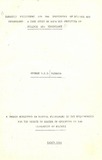| dc.description.abstract | This study examines the evolution of the
philosophy and spirit of Harambee and how it has been used
to establish and maintain Harambee Institutes of Science
and Technology. Special attention is given to how these
institutes relate to the total government educational
policy. It is argued that, though they represent a
potentially crucial element in the process of economic
and social change, their true potential has vet to be
realized, and as they exist today, they can at be~t have
only a marginal impact upon the course of development.
The purpose of this study, therefore, was to examine
and describe the present status and role of Harambee
institute of science and Technology, using Sang'alo
Institute of Science and Technology as a case study. In
particular, the study focuses on the role being played by
Sang'alo Institute in making contributions towards satisfying
the socio-economic needs of the people of Bungoma District.
The sample study population-comprised a total of
184 respondents. Of these 71 were current student trainees
enrolled in the first, second and third yea~ training
programmes at the institute; 44 former trainees (Graduates)
of the institute currently workinq in various parts of the
Republic; 9 staff members of the institute; 3 members of
the Board of Governors; 3 members of the Board of Trustees
and 54 randomly selected members from different I backgrounds ,
of the community.
Four· research questions and various related
sub-problems were developed to guide the data collection
and analyses. The investigation proceeded on the basis
of the established formal primary and secondary research
techniques, using questionnaires and- personal
interviews' and reviewing of the related literature.
Where.as the responses from the questionnaire were computer analyzed,
those from the interviews were summarized. All
the responses were then discussed and presented decriptively,
making use of Tables and frequencies. A total of
·66% usable returns of the expected 75% was considered to
be satisfactory for the purposes of this study.
The major findings were as follows: (1) There was
a dire need for a College of Science and Technology by the
Bungoma people. Its location at Sang'alo was because of
the available farm and the infrastructure on it;
(2) that. the structural organization of the institute
permitted and facilitated the training programme; (3) despite
the fact that the institute is a Harambee project, its sources
of finances are varied;
(4) that the institute is making
contributions towards satisfying the· socio-economic needs
of Bungoma district. | en |

